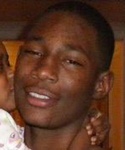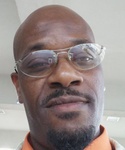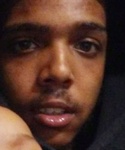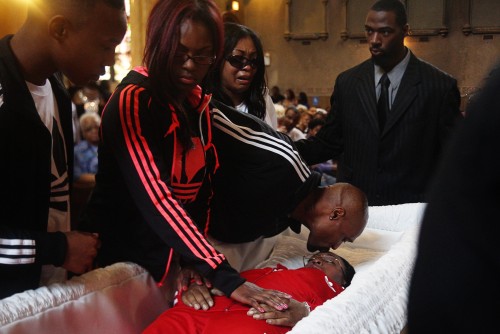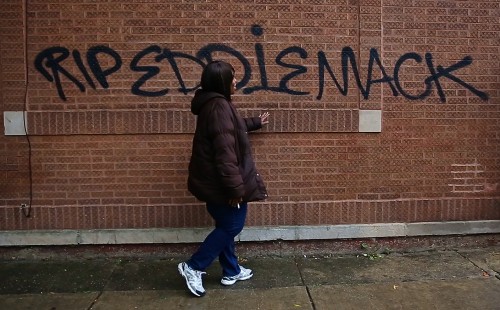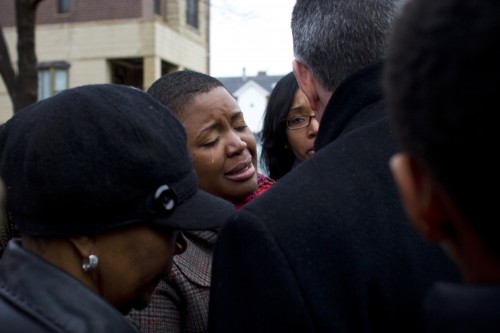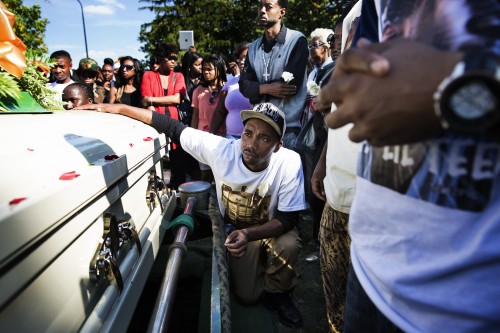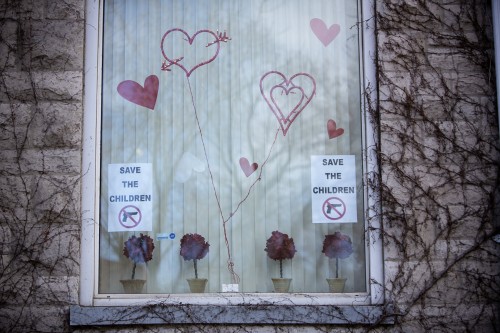By MICHAEL LANSU, JESSICA KOSCIELNIAK AND SAFIYA MERCHANT
Homicide Watch Chicago
Chicago Police Supt. Garry McCarthy checks his cellphone every morning for the latest crime notifications. The news almost always is grim.
Despite averaging 1.1 murders a day, Chicago Police reported a 17 percent decrease in killings from 2012 and the fewest murders in the city since 1965. But McCarthy isn’t celebrating. “This is progress, not success,” he said, “We still have way too much gun violence in this city.”
Despite a drop in murder that has hit nearly a 50-year low, countless family members and friends of the 2013 Chicago murder victims don’t get to reset their losses Jan. 1.
“There is no happy holidays here at the Hardmons,” said Tiffany Hardmon, whose 19-year-old daughter, Ashley Hardmon, was shot to death July 2 near their Austin neighborhood home.
“[Ashley] was the very first one in the holiday season to make sure she had a Santa Claus hat,” Hardmon said from her undecorated home. “I just couldn’t put [only] four stockings up there this year. And I couldn’t bear putting hers up … because I couldn’t bear looking at an empty stocking with her name on it.”
The average Chicago homicide victim in 2013 was a 19-year-old black man, according to medical examiner’s office data. August had the most killings, with 50. The least violent month was February, with 13.
On Oct. 9 in the Humboldt Park neighborhood, Eddie Murphy, 21, was found dead on the sidewalk in the 600 block of North Springfield, with multiple gunshots to the head. Police said he had gang affiliations.
“I felt like I couldn’t help him,” said his mom, Tarinda Henderson, “If I only could have got him out of the streets and into something positive. He sold drugs. He was a drug dealer.” Still, Henderson believes Murphy didn’t deserve to die and was starting to change his life.
“It doesn’t matter what he did; everybody gets a second chance,” she said. “I feel like they don’t care because he is just another black man gone, that they don’t have to arrest [anyone].
“We can’t send our kids off to school because we are buying caskets,” Henderson said.
Despite the bloodshed, Chicago had about 750 fewer shooting victims compared with 2012. The greatest drop in murders was in the notoriously violent Chicago Lawn, Near West Side, New City, Washington Park and Woodlawn communities.
McCarthy credits the leadership of his district commanders. The police department also dissolved special units to put more officers on beat patrols, flooded high crime areas with officers and implemented a gang violence reduction strategy.
Ald. Latasha R. Thomas (17th) has seen the improvements in her Southwest Side ward.
“Supt. McCarthy is working in earnest with police district commanders to attack those factions of gangs and narcotics distribution that account for the vast majority of homicides in Chicago,” Thomas said. “I’d like to think that the sit-downs that are occurring between CPD and leaders of these factions to discuss ways to end the shootings and murders citywide are helping young men find another way out of these dangerous lifestyles.”
The most significant improvement came in the Chicago Lawn community, which had 13 fewer murders in 2013. The New City community had 11 fewer murders, and the Deering police district, which patrols a portion of that area, had 17 fewer murders and at least 100 fewer people shot in 2013, McCarthy said.
“The worst places have had the biggest reductions,” McCarthy said. “But while they have the most significant reductions, there is still a lot more work to be done.”
The most high-profile murder of the year occurred Jan. 29 when Hadiya Pendleton, 15, was gunned down in Harsh Park in the Kenwood community, an area near President Barack Obama’s home.
Michael Ward and Kenneth Williams were charged with Pendleton’s murder, one of 41 killings during the bloodiest January in Chicago in a decade.
“Statistically, [the decline in murders] brings hope because we’ve been mourning for a year now of the loss of our baby, and trying to raise awareness and get the word out,” said Hadiya’s mother, Cleopatra Pendleton.
McCarthy said 67 of the 77 communities had declines in violent crimes over the past two years, but not every community had fewer killings in 2013.
The South Shore community had seven more murders and neighboring Avalon Park had five more. On the West Side, the East and West Garfield Park communities collectively had five more murders.
“When the murder victim is gone, other people are left behind to deal with it,” McCarthy said.
One of those victims was Hardmon, who recently returned home from Paul Simon Jobs Corp, where she was studying to be a pharmacy technician. She was shot in the head while talking with friends in the 4800 block of West Potomac. Police are still searching for her killer.
“Nothing can replace her. Six months feels like forever,” said Hardmon’s younger brother, 15-year-old Anthony Hardmon.
The Rev. Ira Acree of the Greater St. John Bible Church presided over the funerals of numerous West Side murder victims, including Hardmon. “I wouldn’t wish that on my worst enemy,” Acree said, “for somebody to have to deal with someone murdering your child.”
On the South Side, Englewood had the greatest increase in murders in 2013, although police noted the area has been on an overall downward trend in recent years.
“We’ve seen a major decrease here,” said the Rev. Michael Pfleger of The Faith Community of St. Sabina in the nearby Auburn Gresham neighborhood. “[But we must be] very careful that now people don’t kind of lull themselves into a sleep,”
After murders peaked at 943 in 1992, they have been on a general decline until 2012, when a spike to 503 murders brought Chicago’s violence into the national spotlight and popularized the nicknames “Chiraq,” “Shot-Town” and “Killinois” on social media.
The Cook County medical examiner’s office reported 443 homicides as of Friday, including 13 police-involved shootings, three killings on expressways investigated by Illinois State Police and other deaths that Chicago Police either ruled justified or remain under investigation.
Despite the decline in murders, residents in Chicago’s most violent communities still say they feel unsafe. “I live around here. There is too much violence, too many shootings, robbery and gangs,” Lanean Smith, 21, said as she waited for a bus in the Greater Grand Crossing area.
McCarthy, who noted studies that show the perception and reality of crime rarely match, said the best way for police to change perceptions is to reduce crime.
“I’m not going to rest until people feel the reality of these numbers,” Mayor Rahm Emanuel said.
mlansu@suntimes.com | Twitter: @mikelansu
Jkoscielniak@suntimes.com |Twitter: @photojesko


